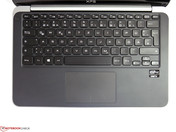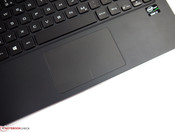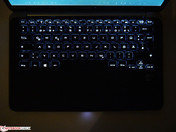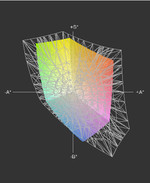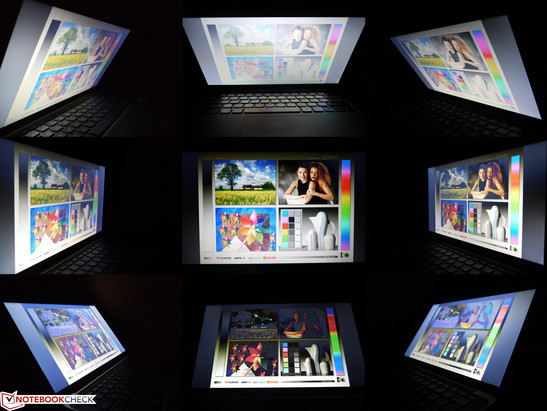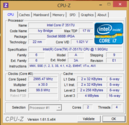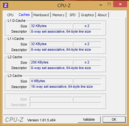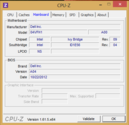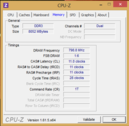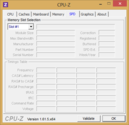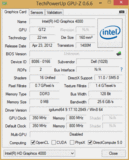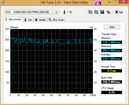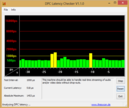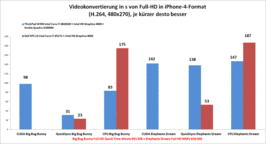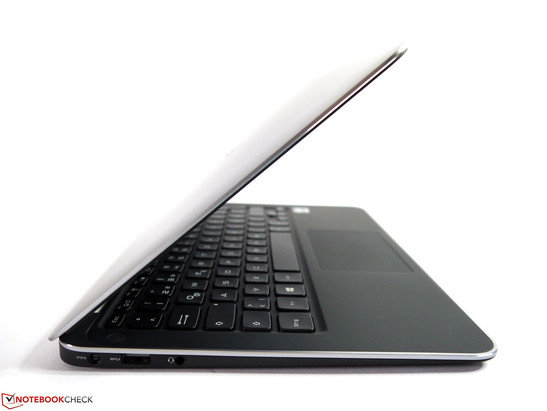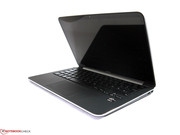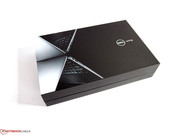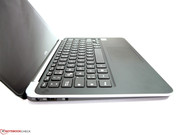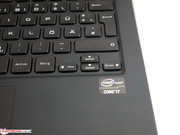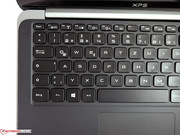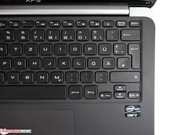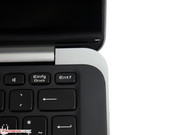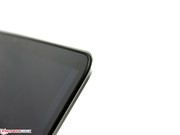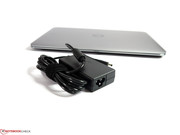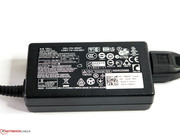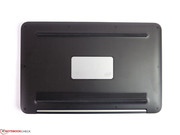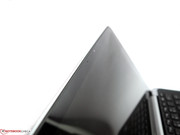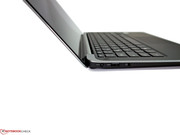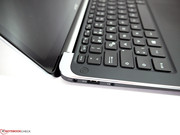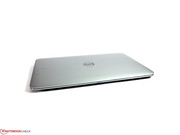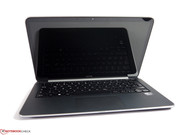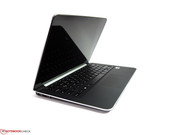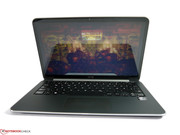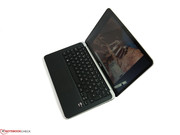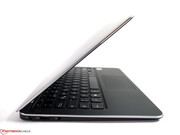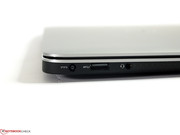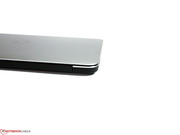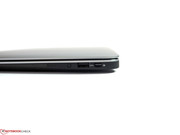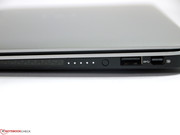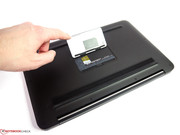Review Dell XPS 13 Ultrabook (Late 2012)

For the original German review, see here.
The concept of an ultrabook was coined by Intel to make PC makers sell more machines with designs that could compare to the extremely popular MacBook Air which is seen as a pioneer, focusing on the portability and design. The Dell XPS 13 follows suit with a similar design by putting in a 13-inch display in a 11-inch case making it an extremely small footprint. The hallmarks of the notebook are the excellent materials of construction, low power consumption and decent performance.
The Dell XPS 13 reviewed in March was criticism good offering but still had its flaws. The late 2012 model has updated hardware components that should provide much better performance than the earlier version. Our test device sports Intel's Core i7-3517U with integrated Intel HD Graphics 4000, 8 GB of RAM and a 256 GB (gross) solid state drive. Windows 8 is now used as the operating system of choice. The price for the test configuration in Dell's online shop is 1299 Euros (~$1750 + plus shipping) and includes a discount of 100 Euros (~$130).
Case
The case is made of a carbon fiber to keep the weight down and reinforced with aluminum bits to keep the chassis stiff. This has been carried over from the last iteration of the laptop and offers great stability and resistance to deformation. The laptop is well put together. The display warping is kept to a minimum and the hinges are strong and hold the display in place without any significant wobbling. The wrist rest is rubber-coated which makes it easy to clean and feels pleasant to use. The bottom is composed of a single large plate which has a nice textured finish that is resistant to any deformation. You can find the hardware as well as the non-removable battery under the cover.
Contrary to advertising, the Dell XPS 13 is not a real 11-inch form-factor but a very slim 13-inch laptop in terms of size. Its dimensions are almost identical to those of the Samsung 900X3C or the Toshiba Z830. The Asus UX21 and the MacBook Air 11 10 mm smaller in each dimension but the difference is barely noticeable. The XPS 13 weighing 1.38 Kg is at least 200g heavier than the other ultrabooks in this category. The Samsung 900X3C only weighs 1186 grams and the Toshiba Z830 comes in at 1110 grams. The MacBook Air 11 is the lightest of the bunch at 1070 grams although it is an 11-inch notebook and cannot exactly be placed in this category.
Connectivity
Due to the ultrabook form factor users will have to settle for a number of compromises in the connectivity department. Users will have to be content with 1 powered USB 2.0, 1 USB 3.0 for faster peripherals and a mini DisplayPort for external monitors. An adapter for the mini DisplayPort is not included. A memory card reader and an RJ-45 Ethernet port are missing. Due to the wedge-shaped design, all interfaces are found towards the back of the case which is good for keeping cable clutter to a minimum and out of the way of the user.
Communication
Intel's wireless Centrino Advanced-N6235 incorporates two antennae and transmits in both the 2.4 GHz as well as the 5 GHz bands. Theoretically, transmission rates of up to 300 Mbit/s would be possible. We tested the signal at three different locations and varying distances but did not observe any irregularities. Compared with an Atheros AR9485WB Wi-Fi adapter, the signal is a bit better. The Wi-Fi chip also sports a Bluetooth 4.0 module that is often used for connecting to cell phones, smartphones and mice. Dell's XPS 13 does not have much more to offer apart from a 1.3 MP webcam for video chats.
A UMTS, HSPA or LTE module for connecting to mobile broadband is not available. The user will have to fall back on external options like a mobile UMTS router, tethering via smartphone or USB dongles when required. The ultrabook also lacks a conventional network socket for cabled networking.
Accessories
The Dell XPS 13 does not come with any accessories despite its premium price point. There is neither an adapter for the rare mini DisplayPort nor a system recovery DVD in the box.
Maintenance
The bottom is fastened via 10 Torx-5 screws and can be easily removed. Dell has, as often before, included detailed instructions in the Owner's Manual. Which components can be exchanged is also explained here. The fan is accessible and easy to clean. The mSATA drive and wireless module can be replaced but not the working memory. It features a capacity of 8 8GB and is soldered which makes it impossible to upgrade. The 8GB RAM is installed in two banks enabling them to work in dual-channel mode which is very different from what is stated in the manual.
Warranty
The Dell XPS 13 includes a one year on-site hardware service for the next business day (in addition to the statutory warranty). It can be upgraded to two (140 Euros/~$190) or three years (187.60 Euros/~$250).
Input Devices
Keyboard
The keyboard in our test model features high-contrast, standard-sized keys with dimensions of 19 x 19 mm and is available in the German layout. The enter key is a bit small and the vertical arrow keys are a bit cramped. The short key drop and soft stroke need getting used to, but they compensate that with quiet typing noise. However, we ascertained a area around the "U" and "I" which are louder than the rest of the keys on the test model. The keyboard fit is not quite right which is a rather large problem for a premium device.
The very bright keyboard backlight proves to be very beneficial in dark work environments. Regrettably, the settings are only limited to two levels.
Touchpad
The relatively large touchpad offers a lot of room and features pleasant gliding traits. Inputs are accepted well and enable a smooth work flow. Individual settings can be found in the Cypress driver and range over the usual one and two finger inputs up to four-finger gestures that can be enabled or disabled individually. The touchpad buttons incorporated in the pad need familiarization and their reliability decreases toward the center which is construction-related.
Display
According to the key specifications, Dell's Truelife screen resolution is only standard fare. With a resolution of 1366 x 768 pixels (118 dpi) and the reflective surface, this is one of the worst displays on a premium device. The Asus Zenbook UX31, for example, has a resolution of 1600 x 900 pixels and the Samsung 900X3 provides a matte surface. The Sony Vaio VPC-Z23 has one of the best matte Full HD TN panels on the market.
| |||||||||||||||||||||||||
Brightness Distribution: 88 %
Center on Battery: 200 cd/m²
Contrast: 486:1 (Black: 0.545 cd/m²)45.57% AdobeRGB 1998 (Argyll 2.2.0 3D)
65.3% sRGB (Argyll 2.2.0 3D)
44.42% Display P3 (Argyll 2.2.0 3D)
The CMO screen in Dell's XPS 13 has an average brightness of 246 cd/m² and is illuminated quite homogeneously with an average of 88%. Light spots, clouding or other brightness differences are not visible to the naked eye. The high brightness is quite sufficient for indoor use, but isn’t sufficient for working outdoors under bright light. The integrated light sensor responds to the ambient light without delay and usually finds the right brightness level. This would be beneficial on a matte screen, but many users will likely disable this feature due to the glare-type screen.
It is difficult to work outdoors without strain on cloudy days even when using maximum brightness and depending on the screen's positioning. This is partly because the maximum brightness is dimmed to 200 cd/m² on battery, and due to the very reflective Gorilla Glass surface. The reduced brightness cannot be changed in either the BIOS or in the energy settings.
The contrast of 486:1 surpasses many standard screens and reproduces saturated colors and dark blacks at ideal viewing angles. This is particularly good for pictures, movies and games since they look more vivid. The screen only covers roughly 60% of the sRGB color spectrum which is similar to other laptops which offer similar panels at much cheaper prices.
The TN panel is of standard fare and hence provides very poor viewing angle stability. The image quality is extremely susceptible to shifts in the vertical viewing angle. The image fades or inverts as soon as the screen is tilted to the front or back beyond that the ideal. Changes in the horizontal viewing angles result in a reddish hue and loss in brightness.
UPDATE: There have been reports from CES 2013 which detail the inclusion of a 1080p panel in the next generation of XPS ultrabooks.
Performance
The Dell XPS 13 is currently available in several preconfigured versions. The differences primarily affect the CPU, RAM and SSD size. It is possible to choose among various combinations using Intel's Core i5-3317U and the Core i7-3517U processors, 4 or 8 GB of RAM and 128 or 256 GB SSD storage devices. Our test device is the premium model and is configured with the Core i7 CPU and the maximum storage capacity available from the OEM. Intel's QS77 chipset, designed for efficiency like the CPU, serves as the basis and is optimized for use in ultrabooks. All versions use the CPU-integrated Intel HD Graphics 4000 graphics unit.
Processor
Intel's energy-efficient Core i7-3517U including the graphics has a thermal design power (TDP) of 17 watts. Its performance can be compared with Intel's Core i5-2430M CPU, which twice the TDP. Familiar features like Hyper Threading, a 4 MB L3 cache and Turbo Boost technology are available despite the CPU's build for energy efficiency. However, the default frequency of 1.9 GHz is much lower than in conventional CPUs (Core i5-2430M: 2.4 GHz), which particularly leads to a lower idle power consumption.
The processor's performance is impressive. It achieved 4170 points (single-core, 32bit) and 8508 points (multi-core, 32bit) in Cinebench R10. That comes close to the Intel Core i5-2450M CPU average scores in our extensive CPU benchmark chart. The processor also performs really well in the iTunes benchmarks. MP3 files are converted to AAC format with a 42.8x speed.
We did not observe thermal throttling in the Dell XPS 13 even after a long period of constant load. Intel's Core i7-3517U CPU runs consistently at a stable speed.
We also did not notice performance throttling on battery power. We even recorded a slightly better result in Cinebench R11.5 with 2.72 points in the multi-core test. It was a marginally lower at 2.69 points in AC mode.
System Performance
We checked the system performance of the Dell XPS 13 using PCMark Vantage and PCMark 7. The older PCMark Vantage benchmark only provided a few partial results (7828 mem, 9908 gam, 15148 mus, 34252 HDD) and no overall system scores. We presume this is due to an incompatibility with the still new Windows 8 operating system. PCMark 7 ran without problems and achieved a decent result of 4808 points. It is hardly possible to optimize the system performance due to the highly integrated components in the Dell XPS 13. It is just the solid state drive that could be replaced to improve the system's overall performance slightly.
| PCMark 7 Score | 4809 points | |
Help | ||
Storage Devices
Dell opted for an mSATA storage device because of the slim casing. These small cards are solid state drives in a smaller format. In view of performance and available memory capacity, not many compromises have to be made in comparison to full-sized models despite the much smaller build. A Samsung P830 mSATA solid state drive is built into our test device and features a (gross) capacity of 256 GB. The mSATA slot is connected via SATA III and enables exploiting the drive's full performance. With sequential read rates of up to 451 MB/s, a decent 268 MB/s at 32 simultaneously dispersed 4K read accesses and a low access time of 0.2 ms, this drive supplies very good performance figures that can only be surpassed by full-sized, high-end SSDs. Dell hasn’t made any compromises on the quality and performance of the storage device and it is a welcome feature for users who need more storage space and can get it easily when the appropriate size is available in the mSATA form factor.
Graphics Card
The integrated Intel HD Graphics 4000's performance is sufficient for most users and will feel wanting for certain users who wish to run high performance applications or game on the system.
Like the CPU, the graphics unit can dynamically adjust its clock speed. Intel specifies a clock of 350 MHz to 1350 MHz depending on the load level. The tool GPU-Z recorded clock rates of up to 1150 MHz in the Furmark and Cinebench R11.5 Open GL tests.
Since Intel HD Graphics 4000 does not have dedicated memory, the performance is dependent on the working memory configuration. Performance losses of up to 25% are possible when it only runs in single-channel mode instead of dual-channel mode. The technical specifications on Dell's product website invariably state single-channel. Although the working memory of our XPS 13 is soldered like in the other models, it is distributed over two memory banks.
We checked whether the RAM really works in dual-channel mode with memory bandwidth and graphics performance tests. The benchmark results of 5229 points in 3DMark 06, 3290 points in 3DMark Vantage and 672 points in 3DMark 11, which are all above-average in our extensive graphics benchmark chart, indicate a dual-channel configuration. On the other hand, the performance loss due to single channel operation can be ascertained in the models featuring 4 GB of RAM. A 4 GB module is soldered on only one memory bank and thus really works in single-channel mode like Dell specifies.
Regardless of that, the performance is easily enough for common home office tasks. Demanding 3D programs can only be used with significant restrictions. This looks different when Intel's Quick-Sync technology is supported. Then, even performance-devouring tasks, such as video converting, are transferable to the graphics unit at relatively low system load. Beside high speed performance, this alternative particularly benefits from a low CPU capacity. It enables performing other tasks comfortably while running the conversion in the background.
The graphics performance is not reduced under continuous full load or on battery power. The performed comparison benchmarks were almost identical to the ones in the regular tests.
| 3DMark 06 Standard Score | 5229 points | |
| 3DMark Vantage P Result | 3290 points | |
| 3DMark 11 Performance | 672 points | |
Help | ||
Gaming Performance
We looked at Diablo III, World of Warcraft and Anno 2070 to determine the gaming prowess of the laptop. The tested games could be rendered smoothly using low resolution and quality settings. However, there is not much room for higher resolutions and/or quality settings and the integrated Intel graphics solution finds its limits. This assessment should be representative of many other up-to-date games. Our comprehensive laptop gaming performance comparison gives an overview of which games can be played on the Intel HD Graphics 4000.
| low | med. | high | ultra | |
| World of Warcraft (2005) | 79 | 83 | 21 | |
| Anno 2070 (2011) | 45 | 19 | 12 | |
| Diablo III (2012) | 56 | 32 | 26 |
Emissions
System Noise
The system noise of the Dell XPS 13 is very low at 30.6 dB (A) at low loads. The fan spun almost silently in this state. However, the Dell XPS 13 is never completely silent because it always runs its fans at minimum speed. Occasionally, a quiet beep was heard from the solid state drive when it accessed the memory. However, this noise was neither distracting nor does it feature a high-pitch which can put-off the user. It is thus possible to perform many tasks, like word processing, simple image editing or Internet browsing with a very quiet laptop. The fan turned up in medium and maximum load and produced a noise of 43.9 dB (A) to 45.7 dB (A). This is very audible and could annoy some users in the long run. This noise level was heard, for example, in converting tasks or games.
Noise Level
| Idle |
| 30.6 / 30.6 / 30.6 dB(A) |
| Load |
| 43.9 / 45.7 dB(A) |
 | ||
30 dB silent 40 dB(A) audible 50 dB(A) loud |
||
min: | ||
Temperature
Despite the fan's relatively loud load noise, it could not keep the casing's surface temperatures below 50°C in this scenario. A fairly high maximum reading of just below 55°C was reached at the rear. The vent placed between the casing and display hinge for construction-related reasons proved to be a flawed design because the waste heat could not be discharged properly. The Samsung 900X3C has the same problem and also reaches around 55°C at the casing's rear. Apple's MacBook Air 11 and Asus' Zenbook Prime UX31A solve this better and are roughly 10°C cooler with a maximum surface temperature of 46°C and 44°C, respectively.
(-) The maximum temperature on the upper side is 54.7 °C / 130 F, compared to the average of 35.9 °C / 97 F, ranging from 21.4 to 59 °C for the class Subnotebook.
(-) The bottom heats up to a maximum of 52 °C / 126 F, compared to the average of 39.4 °C / 103 F
(+) In idle usage, the average temperature for the upper side is 29.7 °C / 85 F, compared to the device average of 30.7 °C / 87 F.
(+) The palmrests and touchpad are cooler than skin temperature with a maximum of 29.6 °C / 85.3 F and are therefore cool to the touch.
(±) The average temperature of the palmrest area of similar devices was 28.3 °C / 82.9 F (-1.3 °C / -2.4 F).
Speakers
The sound output is on a usable level and can serve with a fairly balanced sound characteristic. Bass and mids are quite audible and only the slightly dominant trebles are overbearing to a small extent. A minor enhancement can be achieved by fine-tuning the sound settings. The volume can be set precisely in 100 levels. Although the maximum volume is good, the louder settings around 90 and more cause slight distortion. The Dell XPS 13 sports an audio combo in/out jack. Headsets and other devices with separate jack cords can therefore not be used.
Energy Management
Power Consumption
While the minimum power consumption of Dell's latest XPS 13 is roughly 0.4 watts lower than that of the March model powered by Windows 7, we ascertained an increase of 0.3 to 5 watts in the other measurements. Dell's XPS 13 treated itself up to a maximum of 37.8 watts during full load. We ascribe the increased rates in high load to the higher performance. The lower idle power consumption however indicates improved energy efficiency. The power supply unit is specified with a nominal power of 45 watts, and therefore has sufficient reserves. We did not observe any power supply induced throttling.
| Off / Standby | |
| Idle | |
| Load |
|
Battery Runtime
As usual, the non-removable battery inside features a capacity of 47 Wh and ensures good battery runtime alongside the consumption rates. A runtime of 9 hours and 39 minutes away from the mains was possible in BatteryEater's Reader's test (energy saving mode, minimum screen brightness, wireless modules off). It still ran for 6 hours and 30 minutes in the Wi-Fi test using a screen brightness of 150 cd/m², energy saving mode and Wi-Fi on. Since Dell's XPS does not sport an optical drive, we played movie files from the storage device. It was possible to run movies for 5 hours and 40 minutes using the same brightness settings and energy saving mode. In BatteryEater's Classic test, with maximum brightness, Wi-Fi on and high-performance mode, Dell's XPS 13 lasted 90 minutes and its minimum battery runtime in full load is pretty good for such performance hardware.
Verdict
Dell's XPS 13 is really a stylish, potent and very well built ultrabook. The conservative looks and high-quality materials are convincing. Its slim dimensions and low weight are not the best for this device category, but nevertheless ensure very good mobility.
These good basic traits are complemented by good battery runtimes, which also back the mobility concept offering over 6 hours of runtime. The noise and temperature emissions in low load are also good and allow work in quiet environments. However, this positive trait is almost reversed when Dell's XPS 13 is put under load. Then, the ultrabook gets loud and also very warm.
One major restriction in use on the move is the screen in the XPS 13. Its glare-type surface, the dimmed brightness on battery power and the poor viewing angle stability are three major qualities that have been poorly implemented. It strongly depends on the user's habits whether the good maximum brightness in AC mode and the comparatively decent contrast can compensate that.
Construction-related drawbacks, such as the mediocre connectivity and few upgrade possibilities, are common to this device category and are found among the competition to a similar extent. However, it is too bad that neither Dell's XPS 13 nor other premium models include the corresponding adapters for the mini-port models in the box.


 Deutsch
Deutsch English
English Español
Español Français
Français Italiano
Italiano Nederlands
Nederlands Polski
Polski Português
Português Русский
Русский Türkçe
Türkçe Svenska
Svenska Chinese
Chinese Magyar
Magyar



